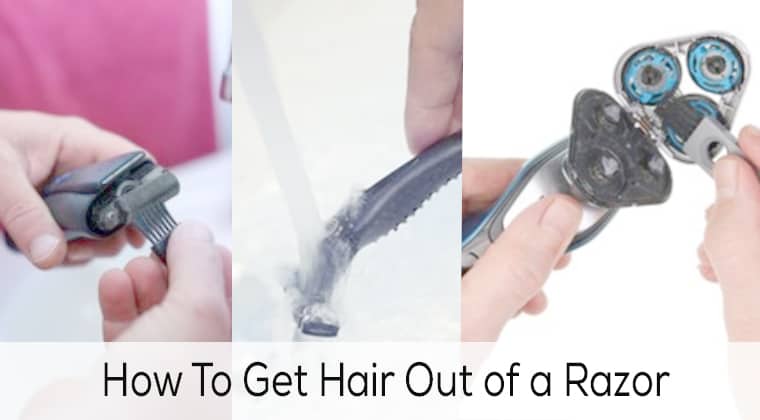In this guide we will discuss how to manually clean your shaver. And how to get hair out of a razor, be it rotary or foil, in only a few quick and easy steps (with detailed images plus video).
No cleaning station? No worries!
And the best part? It’ll literally take you less than a minute.
Regularly giving your electric shaver a thorough cleaning, along with lubrication, is key to extending its lifespan and ensuring peak performance.
While an automatic cleaning station can handle the job, not all shavers include one. Those that do tend to be pricey, with ongoing expenses for cleaning solution.
Thankfully, most modern electric razors are easily cleaned by hand following a simple yet effective routine.
The best way to clean an electric shaver
Having used electric shavers for nearly two decades, I can confidently state that the simplest and most effective cleaning method involves using warm tap water and a small amount of liquid soap.
Naturally, this assumes that your shaver is designed to be waterproof and can be safely rinsed.
If it lacks this feature, you’re essentially limited to dry cleaning (I’ll provide a few tips on that later in the post).
Before we delve into the precise steps ahead, it’s crucial to confirm that your shaver is indeed waterproof and suitable for water-based cleaning.
This crucial information should be explicitly outlined in your shaver’s specifications or user manual.
N.B. DO NOT wash your electric razor with water if it was not designed to handle it because it will get irreversibly damaged.
Before proceeding, make sure the shaver is turned off and it’s not connected to a power outlet. Since we’ll be using water to clean it, you don’t want it to be plugged in for obvious safety concerns.
With that said, let’s see how to get it cleaned.
How to clean an electric shaver (step by step)
Cleaning your electric shaver is essential for maintaining its performance and ensuring a hygienic shaving experience.
In this step-by-step guide, we will walk you through the process of cleaning your electric shaver effectively, whether you’re a seasoned user or a newcomer to electric shaving.
Step 1: Gather Your Cleaning Supplies
Before you begin, make sure you have all the necessary tools and supplies ready:
- Your electric shaver
- A cleaning brush (often provided with the shaver)
- Mild liquid soap or shaver-specific cleaning solution
- A small container for cleaning solution (if needed)
- A clean, dry towel
Step 2: Turn Off and Unplug the Shaver
Ensure your electric shaver is turned off, and if it’s corded, unplug it from the power source. Safety should always come first.
Step 3: Remove the Shaver Head (if applicable)
If your electric shaver has a removable head or cutting unit, follow the manufacturer’s instructions to safely detach it from the main body of the shaver.
Step 4: Shake Out Loose Debris
Gently shake the shaver over a sink or garbage can to remove loose hair and debris. This will prevent clogs and make the cleaning process easier.
Step 5: Brush the Shaver Head
Use the included cleaning brush or a soft-bristle brush to sweep away remaining hair and dirt from the shaver’s head. Pay attention to the crevices between the blades.
Step 6: Rinse the Shaver Head (if waterproof)
If your electric shaver is waterproof, rinse the shaver head under warm running water to remove remaining debris and soap residue. Make sure the water doesn’t get inside the main body of the shaver.
Step 7: Clean with Soap or Cleaning Solution
Depending on your shaver’s instructions, apply a small amount of mild liquid soap or the manufacturer’s recommended cleaning solution to the shaver head. If your shaver has a cleaning station, use it according to the instructions.
Step 8: Scrub and Rinse
Gently scrub the shaver head with your fingers or the cleaning brush to remove any stubborn dirt or shaving cream residue. Then, rinse the head thoroughly under warm water to remove all soap or solution.
Step 9: Dry the Shaver Head
Pat the shaver head dry with a clean, dry towel. Ensure it’s completely dry before reassembling the shaver.
Step 10: Reassemble and Store
If you removed the shaver head, carefully reattach it according to the manufacturer’s instructions. Ensure that all parts are properly aligned. Store your electric shaver in a clean, dry place to prevent dust and moisture buildup.
Step 11: Regular Maintenance
To maintain your shaver’s performance, clean it after each use or as often as recommended by the manufacturer. Replace worn-out parts, such as the blades or foils, as needed to ensure a close and comfortable shave.
Importance of Razor Maintenance
Why It’s Necessary
Razor maintenance is a crucial aspect of personal grooming that often gets overlooked. Proper maintenance not only ensures the longevity of your razors but also contributes to a safer and more effective shaving experience.
Different types of razors require various forms of upkeep, and understanding these guidelines is essential for anyone who values a clean, close, and comfortable shave.
Here are some key points highlighting the importance of razor maintenance and specific guidelines for different types of razors:
- Prolongs Razor Lifespan: Regular maintenance can significantly extend the life of your razors. Proper care can save you money in the long run by reducing the frequency of blade replacements.
- Prevents Bacterial Growth: Razors, especially those used in wet environments, can harbor bacteria and germs. Keeping them clean and dry helps prevent skin infections and irritation.
- Enhances Shaving Performance: A well-maintained razor delivers a smoother and more comfortable shaving experience, reducing the likelihood of nicks, cuts, and razor burn.
- Cost-Efficiency: By keeping your razors in good condition, you can reduce the need for frequent replacements, ultimately saving you money.
- Environmental Impact: Disposable razors, in particular, contribute to plastic waste. Proper maintenance reduces the number of razors you dispose of, which is better for the environment.
Specific Guidelines for Razor Maintenance:
1. Safety Razors:
- Cleaning: After each shave, rinse the blade thoroughly to remove any hair and shaving cream residue. A toothbrush can be handy for scrubbing away stubborn debris.
- Drying: Ensure your safety razor is completely dry before storing it to prevent rust. A razor stand can help with this.
- Blade Replacement: Safety razor blades should be changed regularly. The frequency depends on your usage, but typically, it’s recommended to replace the blade after 5-10 shaves.
2. Cartridge Razors:
- Rinsing: Rinse the razor under running water to remove hair and shaving cream residue. Use a gentle stream to avoid damaging the blades.
- Drying: Shake off excess water and tap the razor gently on a towel. Storing your cartridge razor outside of the shower area will help prevent corrosion.
- Blade Replacement: Cartridge razor blades need replacement when they become dull. This varies depending on how often you shave, but typically every 5-10 shaves is a good rule of thumb.
3. Straight Razors:
- Cleaning: Wipe the blade with a soft cloth or tissue after each use. Remove any soap or lather that may have accumulated.
- Stropping: Regular stropping keeps the blade edge sharp. Strop the razor on a leather or canvas strip before each shave to maintain its keen edge.
- Honing: Periodically, a straight razor will need to be professionally honed. This should be done by an experienced razor technician.
4. Electric Razors:
- Cleaning: Many electric razors come with a cleaning station. If not, detach the shaving head and brush away hair and debris after every use.
- Lubrication: Some electric razors benefit from occasional lubrication of the cutting elements. Follow the manufacturer’s guidelines.
- Replace Cutting Elements: Over time, the cutting elements wear out. Follow the manufacturer’s instructions for replacing them.
The importance of razor maintenance cannot be overstated. It not only saves you money and contributes to a smoother, safer shave but also has environmental and hygiene benefits.
By following specific guidelines for different razor types, you can enjoy a longer-lasting, more efficient shaving experience while reducing waste and ensuring the longevity of your grooming tools.
Common Signs of a Clogged Razor
- Reduced cutting efficiency
- Uncomfortable grip or angle
- Increased pulling sensation
Types of Razors for Maintenance
- Cartridge Razors
- Safety Razors
- Straight Razors
- Electric Razors
Specific Challenges for Each Type
- Cartridge: Multiple blades, hard-to-reach spaces
- Safety: The gap between the blade and the safety bar
- Straight: The entire blade needs to be cleaned
- Electric: Complicated disassembly process
Tools Needed for Cleaning
- Toothbrush
- Tweezers
- Alcohol or disinfectant
- Soap and water
- Soft cloth
- Compressed air can (for electric razors)
Precautions and Safety Tips
Sanitizing the Razor
- Alcohol or boiling water
Handling Blades
- Careful not to cut yourself
- Replace dull blades to avoid clogging
Advanced Techniques for the Devoted Shaver
Blade Sharpening
- For straight razors
- Leather strop technique
DIY Cleaning Solutions
- Vinegar and water
- Baking soda paste
Using Specialized Cleaning Products
- Cleaning sprays and solutions designed for razors
- Where to find them and how to use them
Additional Resources
Additional resources can be invaluable when it comes to razor maintenance. Whether you’re looking for recommended cleaning products, tutorials and videos on razor maintenance, or forums and communities dedicated to shaving and grooming.
There are numerous sources available to help you achieve the best results and stay informed about proper care for your razors.
Recommended Cleaning Products:
- Razor Cleaning Solutions: Some companies offer specialized solutions or sprays designed to clean and sanitize your razors effectively. Brands like Barbicide provide cleaning products specifically formulated for grooming tools.
- Alcohol or Hydrogen Peroxide: These household items can be used to disinfect razors. Soak the razor in alcohol or hydrogen peroxide for a few minutes, then rinse thoroughly.
- Vinegar and Baking Soda: A mixture of vinegar and baking soda can help remove stubborn stains and disinfect your razors. It’s a natural and cost-effective option.
- Ultrasonic Cleaners: For a deep and thorough cleaning of your razors, consider using an ultrasonic cleaner. These machines use high-frequency sound waves to dislodge dirt and debris from the razor’s nooks and crannies.
Tutorials and Videos on Razor Maintenance:
- YouTube: YouTube is a treasure trove of video tutorials on razor maintenance. Search for keywords like “razor maintenance,” “how to clean a razor,” or “sharpening a straight razor” to find informative and visual guides.
- Online Shaving Blogs: Many shaving enthusiasts and experts maintain blogs dedicated to shaving and grooming. These blogs often feature step-by-step guides, reviews of different razors, and maintenance tips.
- Grooming and Shaving Websites: Websites like The Art of Shaving, Sharpologist, and Badger & Blade often provide detailed articles and tutorials on proper razor maintenance.
Forums and Communities Dedicated to Shaving and Grooming:
- Badger & Blade: Badger & Blade is one of the most popular online communities for wet shaving enthusiasts. It features forums covering various aspects of shaving, including razor maintenance, product reviews, and general grooming discussions.
- The Shave Nook: The Shave Nook is a friendly and informative community for wet shaving enthusiasts. It offers a forum dedicated to razor maintenance and restoration, where members can share tips, ask questions, and showcase their razor collections.
- Reddit’s /r/wicked_edge: This subreddit is a bustling hub for all things related to traditional wet shaving. It has an active community that shares advice on razor maintenance, product recommendations, and shaving techniques.
- Straight Razor Place: If you’re into straight razors, Straight Razor Place is a fantastic resource. It features forums dedicated to straight razor maintenance, honing, and restoration.
- The Shaving Room: This UK-based forum offers a community for shaving and grooming enthusiasts. It includes sections on razor maintenance and care.
Using these additional resources, you can find the best cleaning products, access informative tutorials and videos, and engage with like-minded individuals in forums and communities dedicated to shaving and grooming.
This wealth of knowledge and shared experiences will help you keep your razors in top condition and enhance your grooming routine.
Q1: How do I remove hair from my razor effectively?
A1: To remove hair from your razor effectively, follow these steps: First, rinse the razor under warm water to loosen the hairs. Then, use a small brush or an old toothbrush to gently scrub away the remaining hair and debris.
Finish by shaking the razor dry and, if applicable, disinfecting it with rubbing alcohol or a dedicated razor cleaning solution.
Q2: What’s the best way to clean an electric shaver?
A2: Cleaning an electric shaver is easy. First, make sure it’s turned off and unplugged. Remove the head or cutter assembly, if possible, and rinse it under warm water.
Use a cleaning brush to dislodge any stubborn hair. For a deeper clean, follow the manufacturer’s recommendations for disassembly and maintenance. Don’t forget to lubricate the blades if instructed.
Q3: How can I clean a safety razor after shaving?
A3: Cleaning a safety razor is simple. After shaving, rinse the razor under warm water to remove most of the shaving cream and hair.
Use a toothbrush to gently scrub between the blades and around the edges to dislodge any remaining debris. Shake it dry and store it in a dry place to prevent rust.
Q4: Can I use vinegar to clean my razor?
A4: Yes, you can use vinegar to clean your razor. Mix equal parts of white vinegar and water, and soak your razor for about 10-15 minutes.
This can help remove stains and disinfect the razor. Afterward, rinse it thoroughly under running water to remove any vinegar residue.
Q5: How often should I clean my razor for optimal performance?
A5: For optimal performance, clean your razor after each use. This prevents hair, skin oils, and shaving cream from accumulating and affecting the razor’s effectiveness.
Regular cleaning also helps maintain hygiene and prolongs the life of your razor blades.
Q6: What’s the difference between cleaning an electric razor and a manual razor?
A6: Cleaning an electric razor typically involves rinsing the removable parts and using a cleaning brush. Manual razors need a similar rinse, but you’ll also want to dislodge hair from between the blades and thoroughly dry it.
Electric razors may have specific cleaning solutions, while manual razors can benefit from disinfection with rubbing alcohol.
Q7: Are there any specialized cleaning solutions for razors?
A7: Yes, there are specialized cleaning solutions for razors. Some brands offer dedicated solutions designed to clean and disinfect razors thoroughly.
These can help remove stubborn debris and ensure a hygienic shaving experience. Look for these products at your local store or online.
Q8: Can I use compressed air to clean my razor?
A8: While using compressed air can help remove loose debris from your razor, it may not be as effective as other methods, especially for manual razors. It’s better suited for electric razors with removable parts.
However, for a thorough cleaning, rinsing and brushing is recommended in addition to using compressed air.
Conclusion
Keeping your razor clean is crucial for a smooth, irritation-free shave. By following these steps on how to get hair out of a razor, you can ensure your razor remains in top condition, providing you with a consistently close and comfortable shave.
Incorporate these practices into your grooming routine, and you’ll extend the life of your razor and maintain that sharp, clean shave you desire.

Bradley Martyn – Grooming Expert with 20+ years of first‑hand experience testing electric shavers in the United Kingdom, United States, and United Arab Emirates. My reviews are based on rigorous, real‑world testing and a commitment to transparent, unbiased insights.
Our Testing MethodologyI personally evaluate each shaver through multiple shave cycles, both wet (with cream or gel) and dry, assessing closeness, comfort on sensitive skin, battery endurance, and ease of cleaning.
If you found the information useful, consider subscribing to the Trimmereo newsletter as well. It’s free and I only send a few emails per month. Unsubscribe at any time.

